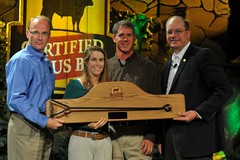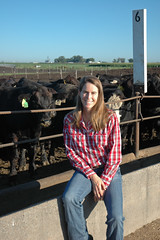A study performed by the Natural Resources Defense Council in 2011 found that in the United States approximately 40% of all food grown for human consumption is wasted. While beef “food waste” is lower than that average, its’ 20% figure still staggers me.
Dr. Kim Stackhouse-Lawson, through her work developing a lifecycle assessment for beef (NSF certified 2013), identified that cutting consumer waste of beef in half would improve the overall sustainability of beef farming by a whopping 10%. As a cattlewoman who cares about environmental responsibility, this statistic caught my attention.
Because I am both a farmer and a consumer, I recently spent some time thinking about things that I do, both at the feed yard and in my kitchen, to reduce waste.
As a Cattle Farmer:
- The majority of my cattle are born and raised in the Sandhills of Nebraska. This unique grassland ecosystem allows for cattle to turn land not suitable for crop production into meat all while improving wildlife habitat and protecting the natural beauty of the land.
- After the cattle move from the ranch to my feed yard in preparation for harvest, more than half of what they eat is “by products”. In other words, during the final phase of beef production, cattle are *recyclers* and eat the part of the plant that is leftover after its’ primary use is complete.
- The majority of my cattle live their entire lives within a two hour radius of my farm which reduces both animal stress and transportation costs. Both of these components lesson the environmental footprint of my beef.
- The waste material (manure) that my cattle produce is recycled by my favorite farmer and used to maintain soil health on our crop farm.
As a Mom and a “food consumer”:
- My favorite farmer and I eat dinner leftovers (reheated for lunch)
- Food not eaten by our family is fed to my favorite teenager’s Rhode Island Red Laying Chickens, and thereby *Recycled* into eggs for our family.
- We make frequent trips to the grocery story (mostly because as a working mom I struggle on organized planning for meal preparation, but on the positive side this decreases the amount of food purchased that deteriorates in the refrigerator before being eaten.)
- Any portion of food individually taken at the dinner table is expected to be eaten. Our girls are good about cleaning their plates and not taking more food than they are able to eat. This facilitates saving leftovers for future lunch use.
It is estimated that food waste costs the average American family of four $1365.00-$2275.00 per year. This out of pocket cost is in addition to the environmental impact of wasted resources as well as food security issues. While reform is needed at each sector of the food production system, food waste at the household level is the most costly as the resources needed to deliver the food to the plate are highest at this last stage of the food production chain.
How do you limit food waste in your kitchen?

Author’s note: Reducing food waste both on my farm and in my kitchen is a personal goal. I plan to revisit this topic periodically and hope that you will share in the journey by thinking of and sharing ways that you too can reduce food waste.
Together we can make a more sustainable planet…















